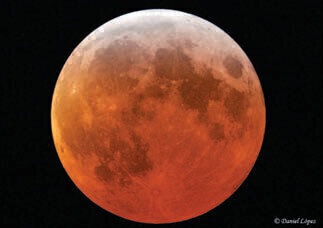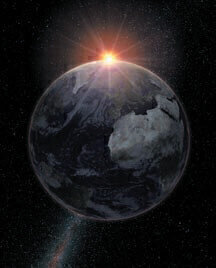-
 Above: The Moon during a lunar eclipse. The red light illuminating the Moon\'s surface during the eclipse has gone through the Earth\'s atmosphere and carried the information of all the major Earth atmospheric components. Courtesy Daniel Lopez, Instituto de Astrofisica de Canarias (IAC).
Above: The Moon during a lunar eclipse. The red light illuminating the Moon\'s surface during the eclipse has gone through the Earth\'s atmosphere and carried the information of all the major Earth atmospheric components. Courtesy Daniel Lopez, Instituto de Astrofisica de Canarias (IAC). -
 An artist?s concept of the sunlight glowing through the Earth\'s thin atmosphere and reaching an observer on the Moon during a lunar eclipse. Courtesy of Gabriel Perez Diaz, SMM, Instituto de Astrofisica de Canarias (IAC).
An artist?s concept of the sunlight glowing through the Earth\'s thin atmosphere and reaching an observer on the Moon during a lunar eclipse. Courtesy of Gabriel Perez Diaz, SMM, Instituto de Astrofisica de Canarias (IAC).
News
Seeking Life in Space - One Step Forward
Aug 05 2009
A group of astronomers from the Instituto de Astrofisica de Canarias (IAC) have found an effective way to study atmospheres of planets for signs of life. Using the Science and Technology Facilities Council’s
(STFC) William Herschel Telescope (WHT) and the Nordic Optical telescope (NOT) on La Palma, they have successfully demonstrated that information on the composition of the Earth’s atmosphere could
be obtained from sunlight that has passed through it. (11th June) in Nature. Similarly starlight passes through a planet’s atmosphere would contain nformation about the constituents of the atmosphere,
providing vital information about the planet itself. This is called a transmission spectrum and even though astronomers can’t use exactly the same method to look at the Earth’s atmosphere, they were able to gain a spectrum of our planet by observing light reflected from the Moon towards the Earth during a lunar eclipse. This is the first time the transmission spectrum of the Earth has been measured and was found to contain not only unmistakeably strong signs of life but also unexpected molecular bands and the signature of the earth ionosphere, (reported in Nature, 11th June). Enric Palle, lead author of the paper, from the Instituto de Astrofisica de Canarias, said, “Now we know what the transmission spectrum of a inhabited planet looks like, we have a much better idea of how to find and recognise Earth like planets outside our solar system where
life may be thriving. The information in this spectrum shows us that this is a very effective way to gather information about the biological processes that may be taking place on a planet.”
Pilar Montañes-Rodriguez, from the Instituto de Astrofisica de Canarias, added, “Many discoveries of Earth-size planets are expected in the next decades and some will orbit in the habitable zone of their parent stars. Obtaining their atmospheric properties will be highly challenging; the greatest reward will happen when one of those planets shows a spectrum like that of our Earth.” Professor Keith Mason, Chief Executive of the Science and Technology Facilities Council (STFC), said, “This new transmission spectrum is good news for future upcoming ground and space based missions dedicated to the search for life in the Universe. The
UK is committed to cutting edge science and UK owned facilities like the WHT are helping to make many groundbreaking discoveries and expand our knowledge of the Universe. Not only do these results improve our knowledge of our own planet but we now have an effective way to search for life on the increasing number of exoplanets (not in our solar system) being found by astronomers.”
Digital Edition
Lab Asia Dec 2025
December 2025
Chromatography Articles- Cutting-edge sample preparation tools help laboratories to stay ahead of the curveMass Spectrometry & Spectroscopy Articles- Unlocking the complexity of metabolomics: Pushi...
View all digital editions
Events
Jan 21 2026 Tokyo, Japan
Jan 28 2026 Tokyo, Japan
Jan 29 2026 New Delhi, India
Feb 07 2026 Boston, MA, USA
Asia Pharma Expo/Asia Lab Expo
Feb 12 2026 Dhaka, Bangladesh


















